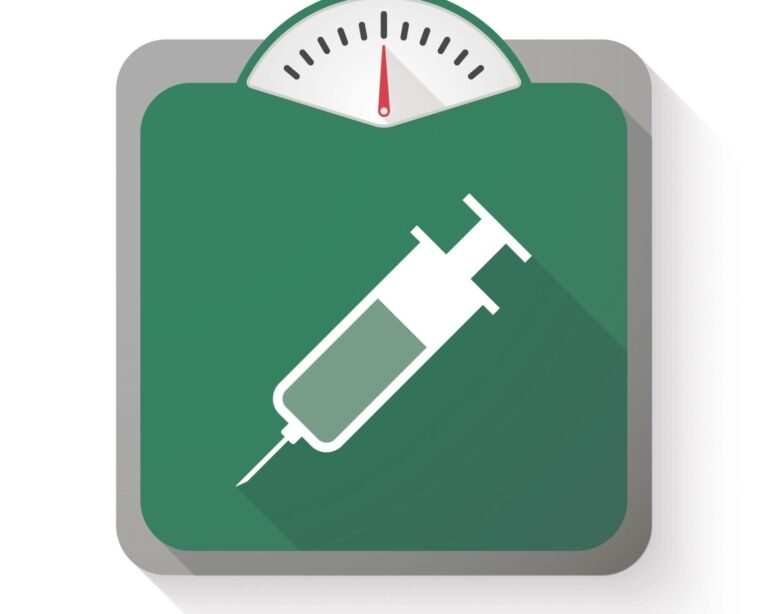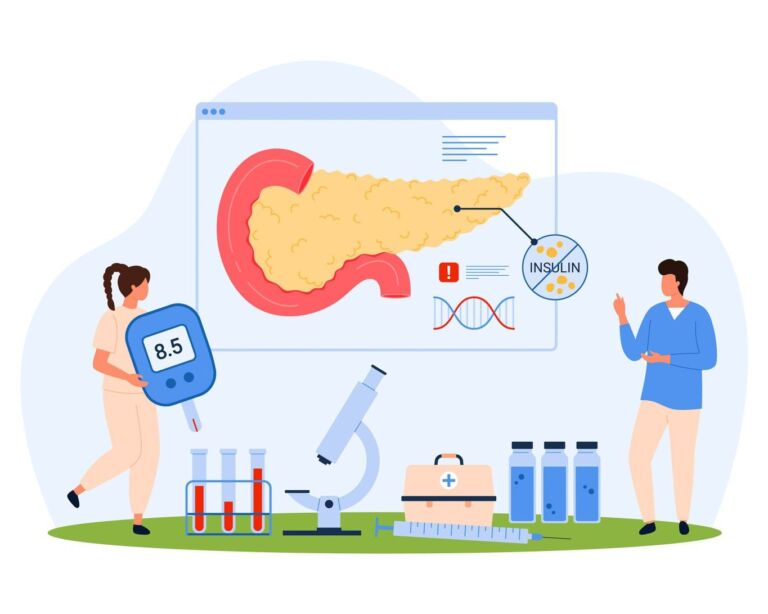Overview: What is diabetes?
Diabetes mellitus is a chronic metabolic disease. There is permanently too much sugar circulating in your blood. The elevated blood sugar level damages your vessels and different organs.
Experts distinguish mainly two forms of diabetes:
- the relatively rare type 1 diabetes (about 5 percent),
- type 2 diabetes mellitus, which is responsible for 90 percent of the diseases
Type 1 diabetes mellitus is caused by an autoimmune disease that destroys all insulin-producing cells in the pancreas.
Type 2 diabetes mellitus is one of the diseases of civilization. About 425 million people worldwide are living with this disease, of which about 60 million are in Europe. At the same time, the number of people affected is rising continuously worldwide. The main reason for this is that more and more people are overweight. Obesity and too little physical activity, along with strong heredity, are the main risk factors for type 2 diabetes mellitus.
The key role of the hormone insulin
Dextrose (glucose) is one of the body’s most important sources of energy. It enters the blood through food. Certain cells of the pancreas, the beta cells, produce the hormone insulin. It ensures that your body cells can absorb and process glucose.
After a meal, the pancreas releases insulin into the blood. It docks onto certain receptors in the body’s cells and causes the cell membrane to allow glucose into the cell. Without insulin, the sugar remains in the blood – and thus cannot bring energy to the cells. As a result, blood sugar levels rise. Insulin is like the key that unlocks the cells so they can take up glucose.
Insulin is not only important for the utilization of glucose. It also plays an important role in fat metabolism and in the utilization of amino acids.
Diabetes mellitus: causes and risk factors
Elevated blood glucose levels trigger the symptoms of type 1 and type 2 diabetes mellitus. But there are different causes for the two forms of diabetes.
Causes of diabetes mellitus type 1
Only about five out of every 100 people with diabetes suffer from type 1. It used to be called juvenile diabetes because it can often begin in adolescence. The pancreas of affected individuals no longer produces insulin. They must therefore regularly inject the hormone insulin throughout their lives to keep their elevated blood glucose levels in check. Women and men are equally affected.
Today, it is considered certain in research that diabetes mellitus type 1 is an autoimmune disease. The immune system produces cells and makes antibodies against the pancreatic beta cells that produce insulin. These cells destroy the beta cells until, over the years, they no longer produce insulin at all. When about 70 to 80 percent of the insulin-producing cells have been destroyed, type 1 diabetes manifests itself with typical symptoms such as elevated blood glucose levels. Weeks, months or even years can pass between the onset of the disease and the appearance of the first symptoms.
Risk factors for type 1 diabetes
- Genetic predisposition: Almost all people affected by type 1 diabetes carry special markings on their white blood cells: the so-called HLA traits DR 3 and DR 4. Therefore, research assumes that genetic predispositions favor type 1 diabetes mellitus. If the father is affected by type 1 diabetes, the children have a five percent risk of also developing the disease. If the mother suffers from type 1 diabetes, the children have a three percent risk of developing the disease. If both parents are affected, their children’s risk increases to about 20 percent. However, many people have a genetic predisposition and still do not get diabetes.
- Viral infections: In addition to hereditary factors, certain viral infections, including mumps and rubella, can contribute to the onset of type 1 diabetes mellitus.
Causes of diabetes mellitus type 2
The pancreas of a healthy person secretes insulin after a meal. The hormone regulates blood glucose levels by stimulating body cells to absorb glucose from the blood. If you have type 2 diabetes, the cells have become resistant to insulin, they only react when insulin levels are high, but the pancreas cannot produce enough. As a result, blood sugar levels shoot up after a carbohydrate-containing meal.
Insulin resistance, which leads to elevated blood sugar levels, develops, for example, if you permanently consume too many calories. Type 2 diabetes is very common in Europe due to frequent obesity. Virtually all of those affected are severely overweight. A body mass index of 30 or higher is considered the most important risk factor for the development of this metabolic disease.
Calculate your BMI
At some point, the amount of insulin your pancreas produces is no longer enough to lower blood sugar levels. This results in a so-called relative insulin deficiency: insulin is present, but the cells do not respond sufficiently to it.
Initially, your pancreas tries to compensate for this deficiency by making even more insulin to keep blood sugar levels down. It works at full speed and exhausts itself after a few years. Then the blood sugar level can rise unhindered.
Risk factors for type 2 diabetes
The majority of diabetes type 2 sufferers show physical changes that are summarized by the term metabolic syndrome. These include the factors:
- Severe obesity with a lot of abdominal fat (increased abdominal girth)
- Lipid metabolism disorder (typical pattern: high triglizeride levels and low (good) HDL cholesterol
- High blood pressure and
- disturbed sugar metabolism (type 2 diabetes develops from the initially disturbed glucose tolerance).
- Heredity: In type 2 diabetes mellitus, hereditary predisposition plays a much greater role than in type 1 diabetes. Children with one parent affected by type 2 have a 30 to 50 percent risk of developing the disease.
- Age: In general, the likelihood of developing type 2 diabetes increases with age. Between the ages of 40 and 70, more men are affected than women; after the age of 70, the ratio reverses. In the past, this form of the disease was therefore also called adult-onset diabetes. In the meantime, however, younger people are increasingly developing type 2 diabetes mellitus. Increasing obesity at a young age is to blame.
Other forms of diabetes
- MODY: Two to three percent of people with diabetes suffer from “maturity onset diabetes of the young“,i.e. “adult-onset diabetes“, which occurs in adolescence. MODY is based on a genetic defect of the insulin-producing cells. Those affected are under 25. years old and of normal weight. So far, 11 MODY types with different courses are known. Genetic testing can confirm the diagnosis.
- Diabetes following damage to the pancreas: If the pancreas partially or completely fails to function, it no longer produces sufficient insulin. In such a case, treatment with insulin is unavoidable. Possible causes of damage to the organ:
- Pancreatitis (caused by alcohol abuse or gallstones)
- Hemachromatosis
- Cystic Fibrosis
- Pancreatic tumors (benign or malignant) for which the organ must be removed
- Gestational diabetes: About 15 to 25 out of 100 pregnant women develop diabetes (gestational diabetes) during pregnancy. Risk factors include being overweight, being over 30 years of age, and having a hereditary predisposition. It usually regresses after birth. The risk of developing diabetes again in the next pregnancy is up to 50 percent. Approximately 35 to 60 out of 100 affected women develop diabetes mellitus in the following ten years.
Symptoms: Diabetes often remains undetected for a long time
Diabetes of all types develops insidiously and usually goes unnoticed for a long time. The usual diabetes symptoms occur mainly when the sugar level in the blood is extremely high and the metabolism is derailed. Then there is a strong change in the water and mineral balance of the organism, at the same time a severe lack of energy in the body cells and central nervous system.
Typical diabetes symptoms include:
- strong thirst
- increased urination
- Weakness, fatigue, exhaustion, lack of concentration
- Itching, dry skin
- Food cravings
- Visual disturbances
- Weakened immune system and susceptibility to infections
Extreme symptoms in diabetes mellitus type 1
Diabetes mellitus type 1 mostly affects young people . Until about four-fifths of the insulin-producing cells of the pancreas are destroyed, the organ can still compensate for the insulin deficiency. Only then do symptoms appear, but these are often much more extreme than those of type 2 diabetes. It happens that the disease first becomes apparent through diabetic coma (coma diabeticum). It occurs as a result of extremely high blood glucose levels. Sufferers pass out and their breath smells of acetone, an odor reminiscent of nail polish remover or very ripe fruit.
Late symptoms in type 2 diabetes mellitus
Diabetes mellitus type 2 initially progresses without any symptoms, sometimes for years. For this reason, type 2 diabetes is often detected late, for example during a routine check-up. Sometimes consequential damage has already occurred.
Possible secondary diseases of diabetes
If people with diabetes mellitus keep a close eye on their blood glucose levels, control them well and maintain a healthy lifestyle, subsequent damage can be avoided. However, if blood glucose is not well controlled and is repeatedly elevated, the small blood vessels (capillaries) in particular are damaged, which can result in damage to the eyes, kidneys and peripheral nervous system.
- Diabetic retinopathy (damage to the retina): One in three cases of blindness is due to diabetic retinopathy. If the smallest blood vessels in the eye are permanently damaged over a long period of time, the blood supply to the retina decreases. This results in the formation of new small blood vessels, which can rupture and lead to bleeding inside the eye and visual disturbances or even blindness. According to statistics, about 90 percent of all type 1 sufferers and about 50 percent of all type 2 sufferers suffer from diabetic retinopathy after 15 years.
- Diabetic nephropathy (damage to the kidneys): Poorly controlled blood glucose levels cause vascular damage to the kidneys. This can lead to kidney failure, requiring regular blood washing (dialysis) or a kidney transplant. In Europe, more than 50 percent of all dialysis patients have diabetes mellitus.
- Diabetic neuropathy (damage to the nerves): Permanently elevated blood glucose levels can damage the blood vessels that supply the small nerve fibers in the arms and legs. As a result, they take damage. This can lead to discomfort in the extremities, such as tingling, pain or burning sensations. In addition, the small nerves of the autonomic nervous system can also be affected, which can lead to disorders of the heart, digestive and genital systems (erectile dysfunction).
- Diabetic foot: Diabetic foot is the most common complication of diabetes mellitus. It is a combination of neuropathy and vascular changes, resulting in open, poorly healing wounds and ulcers in the feet.
- Diabetic macroangiopathy (damage to the large blood vessels): As a result of damage to the large blood vessels, various cardiovascular conditions can occur. For example, diabetes massively accelerates arteriosclerosis (hardening of the arteries). This increases the likelihood of diseases such as
- Heart attack
- Stroke
- Coronary heart disease
- Circulatory disorder of the legs
- Elevated blood lipid levels (LDL cholesterol, triglycerides)
- Hypertension
- Obesity
- Smoking
- Erection problems and reduced sexual arousal: The nerve damage and circulatory disturbances can lead to male potency and erection problems, as well as sexual arousal disorders.
Diabetes mellitus: diagnosis
The term “diabetes” comes from the Greek word for “flowing through”. “Mellitus” means “honey-sweet” in Latin. The name “diabetes mellitus”, meaning “honeyed flow”, refers to the high sugar level of the urine and its sweet taste. Tasting urine used to be a common test for various diseases.
Diabetes mellitus: Measuring blood glucose levels
Nowadays, if we suspect you have diabetes, we will first ask you about your symptoms and then measure the level of sugar in your blood. To do this, you must appear for the blood sample on an empty stomach, i.e. you must not eat anything or drink anything containing sugar eight hours beforehand. Water, unsweetened tea or coffee, on the other hand, are allowed. The laboratory then determines the so-called fasting glucose – a value that tells something about how much sugar (glucose) is in the blood when the last meal was hours ago.
The regular fasting blood glucose level is normally below 5.6 mmol/l (100 mg/dl) in the blood plasma. It does not normally rise above 8 mmol/l (144 mg/dl) after eating. Diabetes mellitus is indicated by a fasting blood glucose reading above 7.0 mmol/l or a blood glucose at any time above 11.1 mmol/l (200 mg/dl) (such as after eating) plus classic symptoms.
Oral glucose tolerance test (oGTT)
If your blood glucose levels are in the borderline range, we can also perform an oral glucose tolerance test (oGTT). In the 72 hours before, do not starve yourself and eat enough carbohydrates. Eight hours before the test you should not eat anything, drink anything containing calories or alcohol or smoke. On the day of the test, we take a blood sample for fasting blood sugar and then you slowly drink 75 grams of glucose dissolved in 250 to 300 milliliters of water in five minutes. Two hours later, we will draw your blood.
In people without diabetes, blood glucose levels in the blood plasma are 5.6 mmol/l (100 mg/dl) on an empty stomach and below 7.8 mmol/l (140 mg/dl) two hours after the test. If fasting values are between 5.6 and a maximum of 7.0 mmol/l (100 to a maximum of 125 mg/dl), there is an abnormal fasting glucose. A value of 7.8-11.0 mmol/l (140 to 199 mg/dl) measured after two hours is a so-called impaired glucose tolerance.
Diabetes mellitus exists when
- fasting plasma glucose values of at least 7.0 (126 mg/dl)
or more
- and for the value measured after two hours (oGTT-2-h value) to be above 11.1 mmol/l (200 mg/dl) .
In pregnant women, the limits for the oGTT are lower.
HbA1c value (long-term blood glucose)
The usual blood glucose test and the oral glucose tolerance test each give a snapshot. With the help of the HbA1c value we can determine the blood glucose level of the last three months. The HbA1c value indicates the amount of red blood pigment associated with glucose. The value allows a conclusion about the quality of blood glucose control in the last 3 months. This period is related to the lifespan of red blood cells, which are regularly renewed. The more often and the longer the blood glucose levels are elevated, the higher the HbA1c value. If the HbA1c value is 6.5% or more, diabetes mellitus is present.
Diabetes mellitus: prevention, early detection, prognosis
Since type 1 diabetes mellitus is an autoimmune disease for which no known therapy exists, you cannot prevent it.
Type 2 diabetes has a hereditary predisposition. However, you can strongly influence whether it breaks out or not through your lifestyle. Most people who develop type 2 diabetes are overweight. Fat deposits on the abdomen around the internal organs are particularly risky. The best way to prevent diabetes is to maintain a normal weight or lose weight and get enough exercise. The important thing is to find a style of eating that is healthy, keeps your body weight constant and satisfies you in the long run. There is a lot of literature about nutrition, courses at adult education centers or through your health insurance company. It’s worth investing time in your diet and knowing what you’re eating. This is because it also helps to prevent other diseases of civilization such as cardiovascular diseases or cancer.
Other factors that prevent diabetes:
- regular exercise (endurance and weight training)
- do not smoke
- consume alcohol only in moderation
- Avoid stress
Early detection of diabetes mellitus
If you have a hereditary predisposition to diabetes or risk factors such as being overweight, you should have your blood glucose levels or your HbA1c checked by a doctor at least once a year from the age of 45.
Course and prognosis
Both type 1 and type 2 sufferers have a good prognosis if diabetes is diagnosed in good time and they succeed in keeping their blood glucose levels permanently within or close to the normal range. You can do a lot yourself to positively influence both your life expectancy and your quality of life. This includes that you
- regularly measure your blood glucose,
- reliably take your medication and
- Avoid risk factors such as obesity, lack of exercise or smoking.
In this way, you protect yourself from a negative course due to the secondary diseases that result from the damaged vessels, such as heart attack, stroke, kidney failure or blindness.
Self-help groups
The exchange with people who are affected by the same disease can be a great support in coping with the disease. Advice on finding a suitable self-help group is available from Selbsthilfe Zürich. Self-Help Zurich and the University Hospital Zurich are cooperation partners in the national project “Health literacy thanks to self-help-friendly hospitals”.



